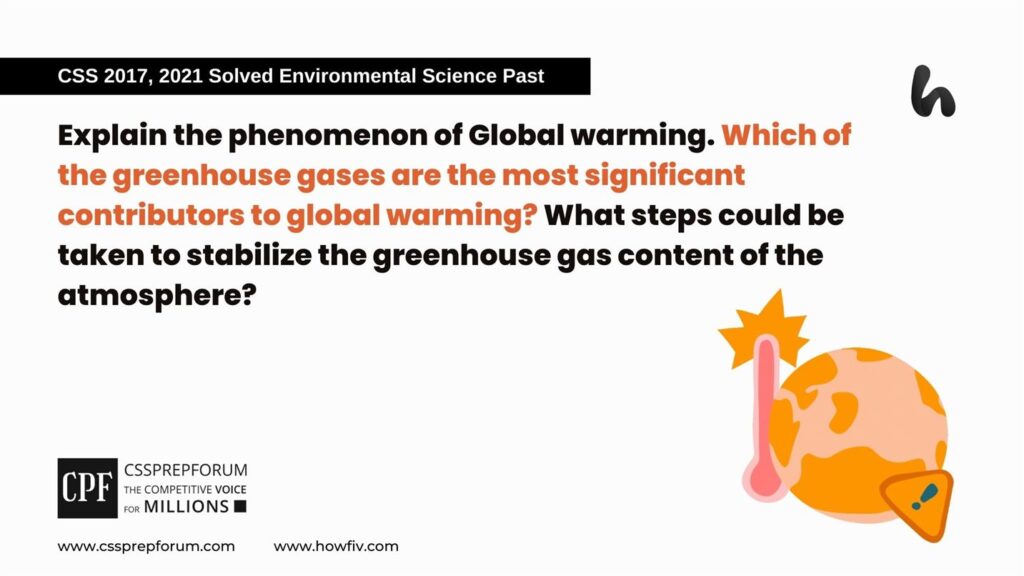CSS Solved Environmental Science Past Papers | Explain the phenomenon of Global warming. Which of the greenhouse gases are the most significant contributors to global warming? What steps could be taken to stabilize the greenhouse gas content of the atmosphere?
The following question of Environmental Science is attempted on the same pattern, taught by Sir to his students, scoring the highest marks in compulsory subjects for years. This solved past paper question is uploaded to help aspirants understand how to crack a topic or question, how to write relevantly, what coherence is, and how to include and connect ideas, opinions, and suggestions to score the maximum.

Question Breakdown
The examiner expects you to explain the phenomenon of global warming along with its most significant contributors. Basically, the question demands you cover three areas. First, an explanation of global warming; Second, an explanation of greenhouse gases that are considered major contributors to global warming; Last, you are asked to explain some important steps to curb this dangerous situation. Make a comprehensive and convincing outline that covers every relevant aspect of your answer that you are to be covered in your answer. By following the outline, you can ensure that you address all the key aspects of the prompt and present a logical and coherent argument. You can make easy and simple diagrams to strengthen your answer. Further, you can validate your answer by providing authentic references from the international community.
Outline
1- Introduction
2- The origin of global warming issue- Scientist Gary Stewart Callendar Case Study
3- Global warming vs climate change
4- Relation of greenhouse effect with global warming
5- Major greenhouse gases –Major contributors of global warming
- ✓Carbon dioxide (CO2)
- ✓Methane (CH4)
- ✓Nitrous Oxide (N2O)
- ✓Chlorofluorocarbons (CFCs)
6- Global warming solutions-Emission reduction strategies
- ✓Invest in energy efficient appliances
- ✓Incorporating the mantra of Reduce, Reuse & Recycle
- ✓Afforestation – Forests as natural carbon sink
- ✓Carbon sequestration
- ✓Public awareness
7- Conclusion

Answer to the Question
Introduction
“Whether the process proves to be Kyoto or something else, let’s acknowledge the urgency of global warming”
Brian Mulroney
With the advent of the industrial revolution, there is a constant emission of hazardous gases resulting from the non-stop burning of fossil fuels and razing of tropical forests. An increase in the temperature of the earth’s atmosphere and oceanic temperature is predicted to be associated with an increase in the emission of greenhouse gases. This average increase in temperature is called global warming. Global warming occurs when carbon dioxide (CO2) and other air pollutants foster in the atmosphere, they absorb sunlight and solar radiation that have already reflected off the surface of the earth. Normally, these radiations would escape into space, but because these pollutants may persist in the atmosphere for many years or even decades, they trap the heat and make the planet hotter. This effect is normally known as the greenhouse effect is the result of these heat-trapping pollutants, notably carbon dioxide, methane, nitrous oxide, water vapours, and synthetic fluorinated gases. Since the earth’s climate has evolved several times over the past 800,000 years as a result of natural cycles and fluctuations, our current era of global warming is solely attributable to human activity, specifically the burning of fossil fuels like coal, oil, gasoline, and natural gas that produce the greenhouse effect. To avert perilous global warming, emissions must be drastically reduced, and fossil fuel alternatives must be used globally. The majority of the worst effects of climate change can be avoided, according to scientists, if we reduce global carbon emissions. To make that happen, the world community needs to act swiftly and decisively. We need to transform our cars and trucks, decarbonize electricity generation by equitably shifting from fossil fuel-based production to renewable energy.
The origin of global warming issue- Scientist Gary Stewart Callendar Case Study
Around half a century after the discovery of carbon dioxide, oxygen, and the other gases that make up the atmosphere, it was first suggested that burning fossil fuels could boost the levels of greenhouse gases—gases that warm the Earth’s surface. But the majority of researchers did not take the notion of global warming seriously until well into the 20th century. In its simplest form, it didn’t seem conceivable that humans could have an impact on the entire globe. For instance, Gary Stewart Callendar, a scientist, discovered in 1938 that measurements of the atmosphere’s carbon dioxide concentration done in the 19th century were significantly lower than those conducted at his time. Other calculations he made led him to conclude that the differences could be explained by the amount of carbon dioxide released into the atmosphere as a result of burning coal, oil, and natural gas since the start of the Industrial Revolution. The concept sparked debate, just as it does now. Callendar was criticized by his scientific peers, some of whom simply rejected the theory because earlier measurements were probably wrong because 19th-century scientists could not have performed as well as the 1930s. It took modern measurement, monitoring, study of Earth’s history, and new concepts to change the way scientists understood life and its environment at a global level.
Global warming vs climate change
Global warming and climate change are often used synonymously. The key difference between climate change and global warming is that the former relates to long-term changes in the global or regional climate patterns, whilst the latter describes an increase in the Earth’s average surface temperature. The average daytime and nighttime temperatures, precipitation, humidity, air pressures, and wind speed and direction are only a few examples of the many variables that make up a region’s climate. Since the Earth’s creation, it has experienced natural climate change. However, at present, this change has been accelerated by many folds, becoming a concern for human beings due to the above-mentioned factors. While on the other hand; the increase in the Earth’s average temperature is referred to as global warming. In other circumstances, climate change is a result of global warming because rising temperatures increase rainfall and alter the lowest and maximum temperatures in a given location.
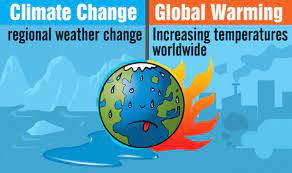
Relation of the greenhouse effect with global Warming
As it is already motioned, the average increase in temperature results from continuous emission of greenhouse gases that cause a special phenomenon called greenhouse effect. Each gas in the atmosphere has its own absorption spectrum, which deals with which wavelengths it absorbs and which it transmits. Certain gases in Earth’s atmosphere are especially strong absorbers in the infrared and therefore absorb radiation emitted by the warmed surfaces of the Earth. Warmed by this, the gases reemit this radiation. Some of it reaches back to the surface, making Earth warmer than it otherwise would be. The process by which the heat is trapped and the gases act a little like the glass panes called the greenhouse effect. The major greenhouse gases are water vapor, carbon dioxide, methane, some oxides of nitrogen, and chlorofluorocarbons (CFCs). The greenhouse effect is a natural phenomenon that occurs on Earth and on other planets in our solar system. Most natural greenhouse warming is due to water in the atmosphere—water vapor and small particles of water in the atmosphere produce about 85% and 12%, respectively, of the total greenhouse warming.
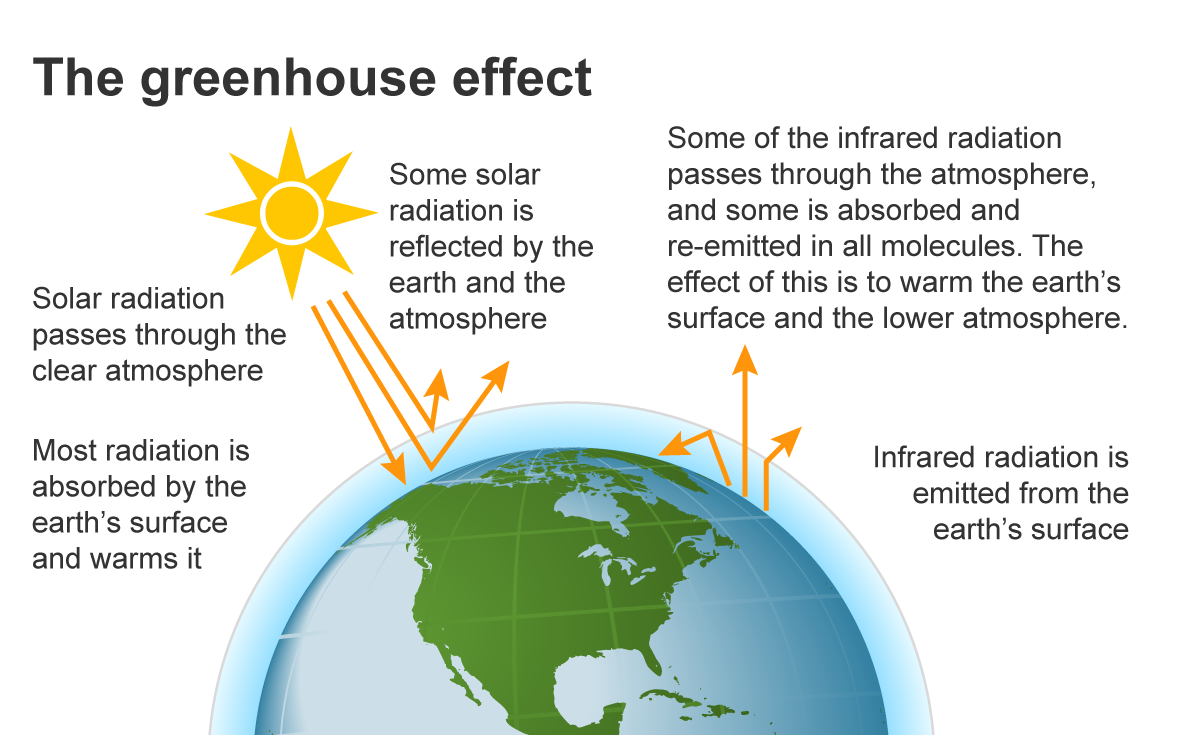
Major greenhouse gases –Major contributors to global warming
Typically, greenhouse gases make up a small fraction, approximately 1%, of the overall gases found in the atmosphere. Their levels are influenced by the equilibrium between the “sources” and “sinks,” which generate and eliminate these gases correspondingly. Human activities have a tendency to raise these levels by introducing new forms of gases into the environment or interfering with the sinks. The major anthropogenic greenhouse gases are discussed in detail below. Carbon dioxide (CO2) is responsible for more than half of this effect, while methane (CH4), nitrous oxide (NO), ozone (O3), and chlorofluorocarbons (CFCs) account for 16%, 5%, 12%, and 12% respectively. However, scientific studies suggest that reducing greenhouse gas production and aerosol emissions may not immediately mitigate the impacts of climate change.
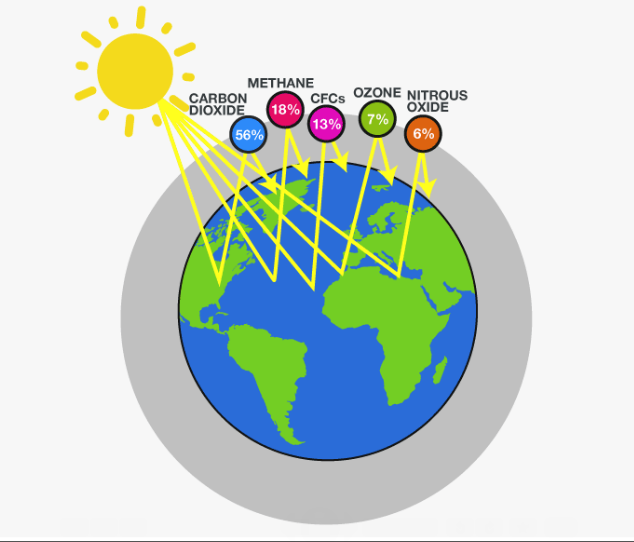
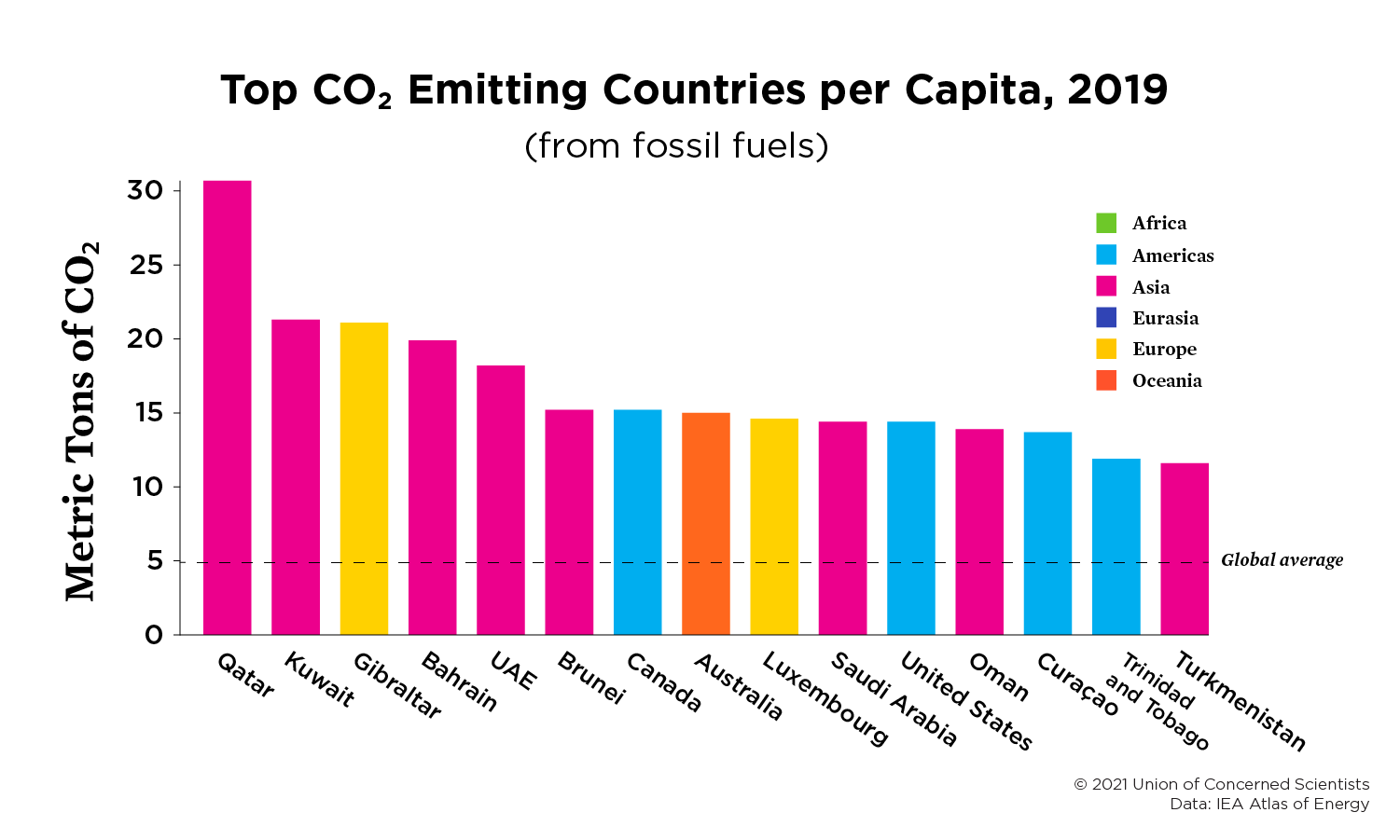
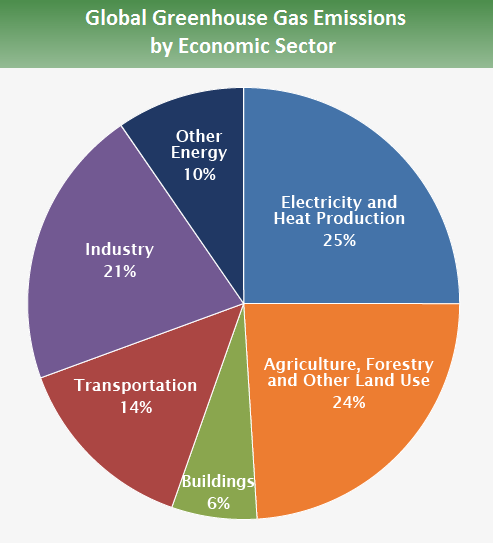
- ✓ Carbon Dioxide (CO2)
The primary origin of CO2 is fossil fuel consumption, but human-induced land use practices such as deforestation, land clearing for farming, and soil degradation can also produce CO2 emissions.
Estimates indicate that roughly 200 billion metric tons of carbon in the form of carbon dioxide (CO2) enter and exit Earth’s atmosphere each year through various biological and physical processes, with 50 to 60% of the anthropogenic greenhouse effect attributed to this gas. Antarctic ice sheet air bubble measurements reveal that carbon dioxide levels in the atmosphere ranged from about 200 to 300 ppm 160,000 years ago, prior to the Industrial Revolution. In recent decades, and particularly in the past few, the concentration of CO2 in the atmosphere has increased rapidly. Presently, the CO2 concentration is approximately 392 ppm, and with a yearly increase of approximately 0.5%, it may reach about 450 ppm by 2050, surpassing preindustrial levels by over 1.5 times.
- ✓ Methane (CH4)
Over the past 200 years, there has been a more than twofold increase in atmospheric methane (CH4) concentration, which is estimated to contribute between 12% to 20% of the anthropogenic greenhouse effect. Methane is produced and emitted by certain oxygen-deprived bacteria that inhabit the intestines of ruminant mammals like cows and termites, as well as oxygen-depleted areas of freshwater wetlands during the decomposition of vegetation. Other sources of methane include seepage from oil fields and methane hydrates, as well as human activities such as landfills (which are the largest methane source in the US), the burning of biofuels, coal and natural gas production, and agricultural practices like cattle farming and rice cultivation where anaerobic activity in flooded fields also leads to methane emissions.
- ✓ Nitrous Oxide (N2O)
Nitrous oxide (N2O) is on the rise in the atmosphere, and recent reports suggested that it could be responsible for up to 5% of the anthropogenic greenhouse effect. Its sources include the agricultural application of fertilizers and the combustion of fossil fuels. According to experts, even if we reduce or stabilize its emissions, the elevated concentrations of N2O are likely to persist for several decades due to its long residence time. Infect, a new study shows that N2O emissions from human activities have increased by 30% over the past four decades, with agriculture being the primary contributor. Fertilizer use, in particular, is responsible for almost two-thirds of global N2O emissions, with the remaining third coming from fossil fuel combustion and other industrial processes.
- ✓ Chlorofluorocarbons (CFCs)
Inert and stable compounds known as Chlorofluorocarbons (CFCs) have been utilized in refrigerators and aerosol propellants. However, their presence in the atmosphere has increased by approximately 5% per year, contributing to 15-25% of the human-made greenhouse effect. Due to their detrimental effects on the ozone layer and contribution to the greenhouse effect, the United States prohibited their use in propellants in 1978. The Montreal Protocol, signed by 24 countries in 1987, aimed to reduce and eventually eliminate CFC production while promoting the development of alternative chemicals. Despite these efforts, CFCs may still cause significant global warming due to their ability to absorb a large amount of infrared radiation, even more than carbon dioxide. Furthermore, their extended atmospheric stability may last for up to a century, despite significant reductions in their production.
Global warming solutions-Emission reduction strategies
It is the need of hour to curb the persisting dilemma of global warming. For this, there are various strategies that can be implemented to tackle the situation. Some of the practical approaches are given below:
- ✓ Invest in energy efficient appliances
Energy-efficient appliances can aid in the reduction of energy consumption and the mitigation of global warming. Appliances like refrigerators, washing machines, air conditioners, light bulbs, and water heaters with the “ENERGY STAR” certification consume less energy, emit fewer greenhouse gases, and have longer lifespans than traditional models. Replacement of traditional energy appliances from energy efficient appliances will help to reduce our energy consumption and help combat global warming.
- ✓ Incorporating the mantra of Reduce, Reuse & Recycle
The mantra of Reduce, Reuse & Recycle is vital for achieving sustainability and combating global warming. It involves minimizing waste and reducing resource consumption. To reduce waste, we must be mindful of our consumption habits, avoid disposable items, and choose products with minimal packaging. Reusing items can be achieved by repairing them, donating or repurposing them. Recycling transforms waste into new products and conserves resources while minimizing landfill waste. Adopting these practices in our daily lives can help to reduce our environmental impact and conserve resources for future generations.
- ✓ Afforestation – Forests as natural carbon sink
Afforestation involves creating new forests or tree plantations on land that has not been forested before. This method is an efficient way of combating climate change, as forests act as natural carbon sinks, absorbing carbon dioxide from the atmosphere through photosynthesis and storing it in their biomass and soil. Along with providing several environmental and social benefits, afforestation should be implemented in conjunction with other methods that aim to reduce greenhouse gas emissions. It is also important to ensure that afforestation is carried out sustainably, considering the needs of local communities and preserving biodiversity and ecosystems.
- ✓ Carbon sequestration
Carbon sequestration is the process of capturing and storing carbon dioxide from the atmosphere to mitigate climate change. It can be achieved through methods such as planting trees, using carbon capture and storage technology, and enhancing soil carbon storage. Carbon sequestration is a complementary approach to reducing greenhouse gas emissions, but should not be seen as a substitute for it.
- ✓ Public awareness
Raising public awareness is essential in combating global warming, and several strategies can be employed to achieve this. Education is a powerful tool, and schools, colleges, and universities can incorporate courses on climate change and sustainability. Media campaigns, public events, government policies, and community outreach programs can also raise awareness. By promoting sustainable practices and renewable energy sources, people can take individual and collective action to reduce greenhouse gas emissions and mitigate the impact of global warming on the planet.
Conclusion
Conclusively, global warming is a complex phenomenon with significant consequences for the planet. Human activities, primarily the burning of fossil fuels, have greatly increased the concentration of greenhouse gases in the atmosphere, leading to a steady increase in global temperatures. Carbon dioxide is the most significant contributor to global warming due to its extended lifespan in the atmosphere, with other greenhouse gases like methane and nitrous oxide contributing to a lesser extent. To stabilize the greenhouse gas content of the atmosphere, we must reduce our dependence on fossil fuels and transition to cleaner energy sources like solar, wind, and hydropower. Additionally, we must encourage energy efficiency, adopt sustainable agricultural practices, and protect natural carbon sinks like forests. These steps will mitigate the effects of global warming and create a more sustainable and resilient future for future generations.
CSS Solved Past Papers’ Essays
Looking for the last ten years of CSS and PMS Solved Essays and want to know how Sir Kazim’s students write and score the highest marks in the essays’ papers? Then, click on the CSS Solved Essays to start reading them.
CSS Solved Essays

CSS Solved General Science & Ability Past Papers
Want to read the last ten years’ General Science & Ability Solved Past Papers to learn how to attempt them and to score high? Let’s click on the link below to read them all freely. All past papers have been solved by Miss Iqra Ali & Dr Nishat Baloch, Pakistan’s top CSS GSA coach having the highest score of their students.
General Science & Ability Solved Past Papers
CSS Solved Pakistan Affairs Past Papers
Want to read CSS Pakistan Affairs Solved Past Papers and learn how to attempt them to score high? Let’s click on the link below to read them all freely. All past papers’ questions have been attempted by Sir Kazim’s students, who scored the highest in the subject.
CSS Solved Pakistan Affairs
CSS Solved International Relations’ Past Papers
Have you opted for International Relations in the CSS examination and want to score above 150? Then, click on the CSS Solved International Relations’ Past Papers by Miss Abeera Fatima, the top IR scorer and the best IR coach in Pakistan.
CSS Solved International Relations Past Papers
Articles Might Interest You!
The following are some of the most important articles for CSS and PMS aspirants. Click on any to start reading.

